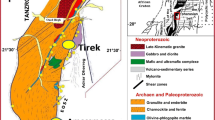Abstract
Fluid inclusion and structural studies were carried out at the Guarim gold deposit in the Palaeoproterozoic Tapajós province of the Amazonian craton. Guarim is a fault-hosted gold deposit cutting basement granitoids. It consists of a quartz vein, which is massive in its inner portions, grading laterally either to a massive or to cavity-bearing quartz vein associated with hydrothermal breccias. The wallrock alteration comprises chlorite, carbonate, white mica and sulphide minerals, with free gold occurring within quartz grains and spatially associated with sulphide mineral grains. Petrographic, microthermometric and Laser Raman investigations recognised CO2-rich, mixed H2O–CO2, and H2O fluid inclusions. The coexisting CO2 and H2O–CO2 inclusions were interpreted as primary immiscible fluids that formed the gold-bearing vein. The H2O inclusions were considered a product of later infiltration of fluids unrelated to the mineralising episode. The mineralising fluid has CO2 ranging typically from 5–10 mol%, contains traces of N2, has salinities of ∼5 wt% NaCl equiv., and densities varying between 0.85 and 0.95 g/cm3. The P–T estimations bracket gold deposition between 270–320 °C and 0.86–2.9 kb; ƒO2–ƒS2–pH estimates suggest a reduced, near-neutral character for the fluid. Variations in the physico-chemical properties, as demonstrated by the fluid inclusion study, resulted from a combination of fluid immiscibility and pressure fluctuation. This interpretation, combined with textural and structural evidence, suggests the emplacement of the mineralised vein in an active fault and at a rather shallow level (4–7 km). The geological and structural setting, deposit-scale textures and structures, wallrock alteration and physico-chemical fluid properties are compatible with those of epizonal to mesozonal orogenic lode gold deposits.
Similar content being viewed by others
Author information
Authors and Affiliations
Additional information
Received: 3 March 2000 / Accepted: 21 October 2000
Rights and permissions
About this article
Cite this article
Klein, E., Alves dos Santos, R., Fuzikawa, K. et al. Hydrothermal fluid evolution and structural control of the Guarim gold mineralisation, Tapajós Province, Amazonian Craton, Brazil. Mineral. Deposita 36, 149–164 (2001). https://doi.org/10.1007/s001260050295
Issue Date:
DOI: https://doi.org/10.1007/s001260050295




